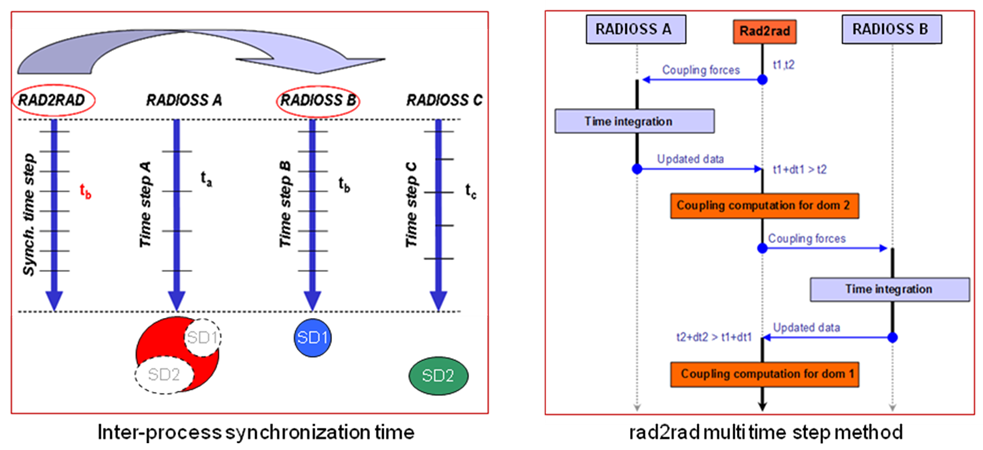Model Setup

Figure 1.
The time step of each subdomain is arbitrary; but to allow the best gain in terms of speedup they should be significantly different from each other.
The best manual decomposition will be obtained by dividing global model into parts with a large number of elements having a big time step on one side, and a small number of elements with small time step on the other side.

Figure 2.
New in 14.0
As of 14.0, Fluid-Structure Interaction simulations, including ALE and/or SPH are possible.
New in 13.0
As of 13.0, Multi-Domain is fully Hybrid-MPP compatible, that is, enabling multiple threading for RAD2RAD.
Hints
- The subdomain should be less than 30% of the full domain (main _ sub-domains) in terms of nodes or elements and the natural (or acceptable mass scaling) time step ratio between subdomain and main domains should be below 1/3.
- Apply the same rule for pure Lagrange or FSI models, which is to put the parts with a significantly smaller time step in the subdomain.
- For pure Lagrange Multi-Domain models, the RAD2RAD workload must be minimized as much as possible by reducing the communication flow between domains, with this aim, contact interfaces and connections between sub and main domains should be minimized as much as possible.
- It is important to check that the subdomain is not part of a global contact interface, but has its own subdomain self-impact and to create cross domain contacts not larger than needed.
- It is strongly recommended to symmetrize each created cross domain contact interfaces.
- For Multi-Domain with ALE or SPH, there is no need to minimize the contact interfaces between fluid and structure.
- For models with a subdomain having a relatively small amount of elements, the number of allocated CPU should respect the empirical rule of at least 2000 element per CPU and it is advised to use the maximum possible number of threads per node of the used cluster.
- In one model, scattered parts with low time steps do not necessarily justify multiple subdomains. If these parts have similar low time steps, they must be put into one subdomain.
- If connections between subdomains and main domains also have a small time step, these connections should be part of the subdomain.
- Subdomains essentially composed of Lagrange 3D elements, make the Multi-Domain less efficient than if it was composed of 2D and 1D elements.
- For Multi-Domain FSI, it is advised to use the fluid in the main domain and defined /DT/ALE with an elementary free time step with a scaling factor of 0.5 for ALE. In the Langrange subdomain a nodal time step /DT/NODA with a scaling factor of 0.9 should be used.